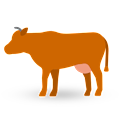Spannrippe
(Knochendünnung)
In German butchery, spannrippe is a cut of beef derived from the forequarter, specifically the lower rib section, which is situated towards the belly of the animal. Spannrippe contains relatively lean meat with noticeable fibrous muscles. Its location on the animal means it has a good amount of connective tissue.
Due to the exercise this part of the cow gets, it has a pronounced beefy flavor. Like other tough cuts, spannrippe is ideally suited for slow-cooking methods that allow its collagen and connective tissues to break down over time. It can be braised, stewed, or slow-roasted.
In German cuisine, it might be used in hearty stews or traditional soups. To harness the full potential of the spannrippe, it's best to cook it slowly and gently. The collagen-rich tissues will break down, turning into gelatin, which adds richness to the dish. Read more
Browning the meat before stewing or braising can add depth to the final flavor. The beefy taste of the spannrippe pairs well with robust flavors. Root vegetables, aromatic herbs, and rich broths or wines can complement and enhance the meat's inherent flavors.
Ingredients like onions, garlic, bay leaves, and juniper berries are often used in German dishes with such cuts.

